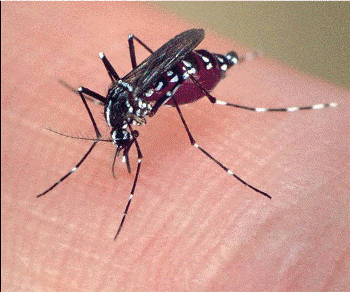By Thomas Moran and K.C. Conaway
 Delawareans and visitors are plagued by a familiar foe this time of year – the mosquito. Mosquitos are not only a nuisance but can also threaten our health because they may transmit diseases to domestic animals, wildlife and pets.
Delawareans and visitors are plagued by a familiar foe this time of year – the mosquito. Mosquitos are not only a nuisance but can also threaten our health because they may transmit diseases to domestic animals, wildlife and pets.
Our Mosquito Control section’s mission is to manage mosquitos in an environmentally compatible way without harming people or domestic animals. To do this, we monitor the populations of many types of mosquitos. If they pose a disease transmission threat or become a nuisance, Mosquito Control uses different methods to reduce or eliminate them. This monitoring process includes applying insecticide at their breeding sources.
Mosquito Control, part of the Division of Fish and Wildlife, also provides public outreach and education to inform Delawareans of our efforts, and what all of us can do to help reduce the number of mosquitos in Delaware.
We focus on large-scale breeding habitats, including saltmarshes, forested wetlands, stormwater ponds, flooded fields and roadside ditches. Not surprisingly, mosquitos around people’s homes can’t be effectively monitored because of the mosquitos’ sheer numbers. That means controlling them in your backyard falls to you or your property’s owner, along with help from us if needed.
Any item or area that can collect and retain water for five to seven days can produce numerous biting mosquitoes. These include
everything from kids' toys to flat roofs to hollows in trees. Reclaim and enjoy your backyard again by eliminating water-holding areas and containers that breed mosquitoes. You’ll be glad that you did!Mosquito-breeding sites are not only a problem because of their proximity to people, but also because of their ability to produce two mosquito species of concern.
One is these is the Asian tiger mosquito, which was accidentally introduced to the U.S. in the early 1980s. Since then, it has become well established in Delaware and elsewhere, and is the number-one nuisance mosquito in our backyards. This small mosquito is easily identified by its vivid white markings on a black body, the single white stripe on the thorax (upper back), and its white-striped legs.
The tiger mosquito is an aggressive human biter, often targeting our lower legs. It bites during the daytime and doesn’t move more than a few hundred yards from where it hatched.
This attribute has led mosquito control professionals to coin the phrase, “if you breed them, you feed them,” meaning that if their breeding habitat is in your yard, they are likely to find and feed on you first. We can mainly control it by simply reducing or eliminating its breeding habitats in our backyards and communities.
The second problematic backyard mosquito is the common house mosquito. It, too, prefers stagnant water. And, like the Asian tiger, it can also be found in backyard containers, as well as in stormwater ponds, street storm drains and similar habitats. These largely night-time mosquitoes feed mainly on birds but will also readily bite humans.
This fact is important to know because not only can they amplify or increase viruses like West Nile by passing them from bird to bird but may also transmit pathogens to us while taking in a blood meal. In fact, the common house mosquito is the main amplifying vector for West Nile virus in Delaware.
Stay inside when most mosquitoes are active – at dawn, dusk and at night.
If you must be outside, wear light-colored, long-sleeve clothing or apply insect repellent containing active ingredients like 20-30% diethyltoluamide (DEET), or products containing picaridin, oil-of-lemon eucalyptus, para-menthane–diol, or ethyl butylacetylaminopropionate (IR3535). All these products have been found to be safe and effective. Be sure to follow all label instructions.
If outside without long-sleeved clothing or repellent, try to avoid vigorous activity or exercise, since mosquitoes are attracted to body heat, sweat and skin odor.
Avoid wearing colognes, body sprays, perfume and dark-colored clothing. These items make you more attractive to mosquitos.
Burn citronella candles or tiki-type torches to provide a limited repellent for a small outdoor area.
Use small handheld devices that utilize heat to disperse repellent to create a zone of protection from mosquitos. These devices are powered by a small butane cartridge that heats a mat saturated with repellent.
Treating your backyard with certain residual insecticides can be effective in reducing mosquitoes in some locations if done safely and appropriately. Many commercial pest control companies now offer this service for a fee. However, there are some concerns regarding possible adverse impacts to other insects and non-target organisms from this type of treatment. Until more is known about these possible side effects, the Mosquito Control Section remains ambivalent about this approach.
Forget bug zappers. They kill far more non-targeted insects than mosquitos, many of which are harmless or beneficial.
More information about mosquito control, including a video of common backyard mosquito breeding habitats, can be found on the Mosquito Control section’s webpage. You can also call one of our two field offices to request mosquito control services. The Newark office covers the northern half of Delaware, including the Dover area, and can be reached at 302-836-2555. Our Milford office serves the remainder of the state south of Dover. That number is 302-422-1512. You can also get Information about the mosquito control program by calling our central Dover office at 302-739-9917.
Thomas Moran and K.C. Conaway are program managers with the Division of Fish and Wildlife’s Mosquito Control section.
A version of this article appeared in the summer 2020 issue of Outdoor Delaware and has been updated.
Related Topics: animals, conservation, education, fun, health, mosquito, outdoor delaware, science